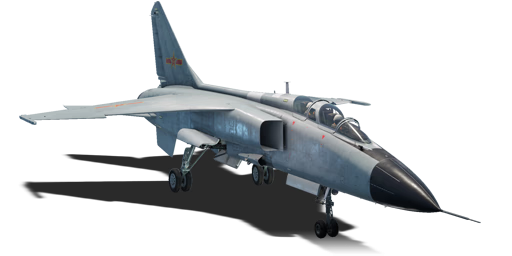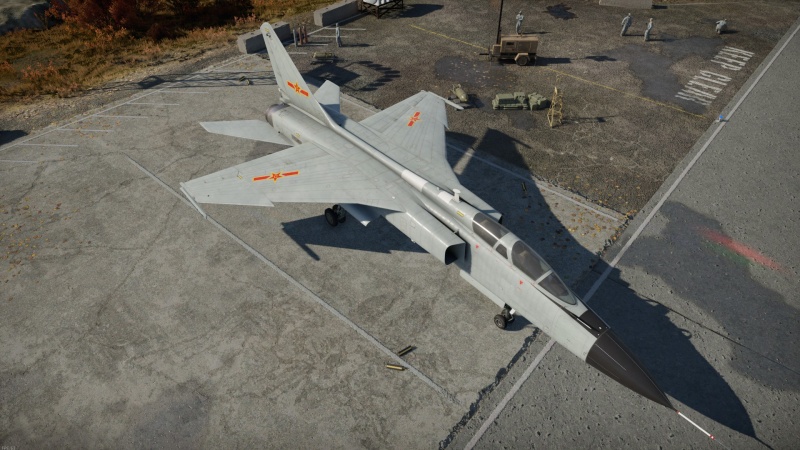JH-7A
Contents
Description
The development program of the JH-7 "Flying Leopard" is a lesser-known but fascinating story in the realm of Chinese military aviation. Initially, the project was aimed at creating a capable twin-engine fighter-bomber during the late 20th century. The JH-7's early history was marked by significant challenges and delays, often due to resource constraints and a lack of access to advanced technology. However, Chinese engineers and aviation experts persisted, and the program eventually gave birth to the JH-7A in 2004, the initial variant of this aircraft. The JH-7A showcased China's determination to bolster its military capabilities, particularly in the realm of precision strike and maritime operations. While it might not have received the same global attention as other strike-fighter aircraft programs of its era, the JH-7 Flounder's journey reflects China's steady progress in the development of its indigenous military technology.
The JH-7A Flying Leopard II (NATO reporting name: Flounder) was introduced in Update "Kings of Battle". Being a dedicated strike-fighter, the JH-7A specializes in the ground-strike role, and suffers in dedicated air-to-air combat at its battle rating, despite having access to the formidable PL-8 and PL-5C all aspect missiles. As such, this aircraft can struggle in dedicated air modes, and instead shines the brightest in mixed battles thanks to its selection of precision ground ordnance and powerful targeting pod. The strong radar and all-aspect missiles can prove to be a strong form of self defence in mixed battles if the need arises. All in all, the JH-7A serves as a major upgrade in technology and capability over its predecessors in the tech tree, namely the Q-5 family.
General info
Flight performance
Describe how the aircraft behaves in the air. Speed, manoeuvrability, acceleration and allowable loads - these are the most important characteristics of the vehicle.
| Characteristics | Max speed (km/h at _,___ m) |
Max altitude (metres) |
Turn time (seconds) |
Rate of climb (metres/second) |
Take-off run (metres) | |||
|---|---|---|---|---|---|---|---|---|
| AB | RB | AB | RB | AB | RB | |||
| Stock | ___ | ___ | 15000 | __._ | __._ | __._ | __._ | ___ |
| Upgraded | ___ | ___ | __._ | __._ | __._ | __._ | ||
Details
| Features | |||||
|---|---|---|---|---|---|
| Combat flaps | Take-off flaps | Landing flaps | Air brakes | Arrestor gear | Drogue chute |
| _ | _ | _ | _ | _ | _ |
| Limits | ||||||
|---|---|---|---|---|---|---|
| Wings (km/h) | Gear (km/h) | Flaps (km/h) | Max Static G | |||
| Combat | Take-off | Landing | + | - | ||
| 0 | 450 | ___ | ___ | ___ | ~__ | ~__ |
| Optimal velocities (km/h) | |||
|---|---|---|---|
| Ailerons | Rudder | Elevators | Radiator |
| < ___ | < ___ | < ___ | - |
Engine performance
| Engine | Aircraft mass | |||||
|---|---|---|---|---|---|---|
| Engine name | Number | Basic mass | Wing loading (full fuel) | |||
| _____ | _ | _,___ kg | ___ kg/m2 | |||
| Engine characteristics | Mass with fuel (no weapons load) | Max Gross Weight | ||||
| Weight (each) | Type | _m fuel | __m fuel | __m fuel | ||
| ___ kg | ___ | _,___ kg | _,___ kg | _,___ kg | _,___ kg | |
| Maximum engine thrust @ 0 m (RB/SB) | Thrust to weight ratio @ 0 m (___%/WEP) | |||||
| Condition | 100% | ___%/WEP | _m fuel | __m fuel | __m fuel | MGW |
| Stationary | ___ kgf | ___ kgf | _.__ | _.__ | _.__ | _.__ |
| Optimal | ___ kgf (_ km/h) |
___ kgf (_ km/h) |
_.__ | _.__ | _.__ | _.__ |
Survivability and armour
Examine the survivability of the aircraft. Note how vulnerable the structure is and how secure the pilot is, whether the fuel tanks are armoured, etc. Describe the armour, if there is any, and also mention the vulnerability of other critical aircraft systems.
Modifications and economy
Armaments
Offensive armament
The JH-7A is armed with:
- 1 x 23 mm Type 23-3 cannon, belly-mounted (200 rpg)
- 84 x large calibre countermeasures
Suspended armament
Describe the aircraft's suspended armament: additional cannons under the wings, bombs, rockets and torpedoes. This section is especially important for bombers and attackers. If there is no suspended weaponry remove this subsection.
Usage in battles
Describe the tactics of playing in the aircraft, the features of using aircraft in a team and advice on tactics. Refrain from creating a "guide" - do not impose a single point of view, but instead, give the reader food for thought. Examine the most dangerous enemies and give recommendations on fighting them. If necessary, note the specifics of the game in different modes (AB, RB, SB).
Pros and cons
Summarise and briefly evaluate the vehicle in terms of its characteristics and combat effectiveness. Mark its pros and cons in the bulleted list. Try not to use more than 6 points for each of the characteristics. Avoid using categorical definitions such as "bad", "good" and the like - use substitutions with softer forms such as "inadequate" and "effective".
Pros:
Cons:
History
Devblog History
After several years of development, China finalized the development of its own fighter-bomber, the JH-7, which ticked all of the boxes that were set out by PLA command for an aircraft to replace the outdated Q-5. In 1999, following orders from the Central Military Committee, work began on creating an improved version of the JH-7. This extensive modernization program included 303 changes, which included improving the fire control system with the introduction of a digital electronic sighting system, as well as increasing the range of its suspended weapons. This updated fighter-bomber, now designated JH-7A made its first flight in 2002, and began entering service in October 2004. JH-7A aircraft are still currently serving in the Chinese Air Force.
Media
Excellent additions to the article would be video guides, screenshots from the game, and photos.
See also
Links to the articles on the War Thunder Wiki that you think will be useful for the reader, for example:
- reference to the series of the aircraft;
- links to approximate analogues of other nations and research trees.
External links
| China jet aircraft | |
|---|---|
| Fighters | J-2 · J-4 · Shenyang F-5 · J-6A · J-7II · J-7D · J-7E · J-8B · J-8F · J-11 |
| Strike aircraft | Q-5 early · Q-5A · Q-5L · A-5C · JH-7A |
| Bombers | H-5 |
| American | ␗F-84G-21-RE · ␗F-84G-31-RE · ␗F-86F-30 · ␗F-86F-40 · ␗F-100A · ␗F-100F · ␗F-104A · ␗F-104G · ␗F-5A · ␗F-5E · ␗F-16A MLU |
| Soviet | ␗MiG-9 · ␗MiG-9 (l) |





